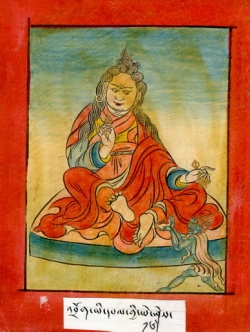Difference between revisions of "Drokmi Pelgyi Yeshe"
(Created page with "thumb|250px| Drokmi Pelgyi Yeshe ('brog mi dpal gyi ye shes) was born at Yamdrok Gang (yar 'brog sgang) into the Drokmi clan. When he received the emp...") |
|||
| Line 1: | Line 1: | ||
[[File:1.Drogmi.jpg|thumb|250px|]] | [[File:1.Drogmi.jpg|thumb|250px|]] | ||
| − | Drokmi Pelgyi Yeshe | + | [[Drokmi Pelgyi Yeshe]] was one of the [[twenty-five disciples of Padmasambhava]]. An able [[translator]], he is also credited with subjugating the [[mamo]] [[deities]] of [[Tibet]] |
| − | Pelgyi Yeshe | + | [[Drokmi Pelgyi Yeshe]] ('[[brog mi dpal gyi ye shes]]) was born at [[Yamdrok Gang]] ([[yar 'brog sgang]]) into the [[Drokmi]] {{Wiki|clan}}. When he received the [[empowerment]] of the [[Eight Great Classes]] from [[Padmasambhava]], his [[flower]] landed on the [[Lamay Heruka]] ([[bla med he ru ka]]) [[maṇḍala]]. Subsequently, when the full [[maṇḍala]] spontaneously appeared before him, all restless tendencies of [[body, speech, and mind]] were consumed in the great [[fire]] of [[intrinsic awareness]]. He became an {{Wiki|adept}} of the [[maṇḍala]] and subdued [[worldly]] [[spirits]], especially [[mamos]], and bound them as servants. |
| − | + | [[Pelgyi Yeshe]] became a learned [[translator]] of many [[tantras]], in particular those of [[Matarah]], or [[Mamo Botang]] ([[ma mo rbod gtongs]]), and trained many [[disciples]] while practicing [[meditation]] on the snow-covered peaks of the mountains in the southern [[Yarlung Valley]]. | |
| − | His reincarnations include the treasure revealers Rashak Chowar (ra shag chos 'bar) and Karak Dechen Lingpa (kha rag bde chen gling pa). | + | Once, while [[Pelgyi Yeshe]] was [[meditating]] at Mt. [[Yarlha Shampo]] ([[yar lha sham po]]) the life-stones of the mountain [[god]] appeared, comprised of fifteen “[[lha lu mi]]” ([[lha klu mi]]) {{Wiki|substances}} that were warm to the {{Wiki|touch}}. These he concealed as [[treasure]], which were to be later revealed by [[Kalden Dorje]] ([[skal ldan rdo rje]]). |
| + | |||
| + | His [[reincarnations]] include the [[treasure revealers]] [[Rashak Chowar]] ([[ra shag chos 'bar]]) and [[Karak Dechen Lingpa]] ([[kha rag bde chen gling pa]]). | ||
| Line 14: | Line 16: | ||
| − | Tarthang Tulku. 1975. Bringing the Teachings Alive. Cazadero, CA: Dharma Publishing. | + | [[Tarthang Tulku]]. 1975. Bringing the Teachings Alive. Cazadero, CA: [[Dharma]] Publishing. |
| − | Smith, Gene. 2006. | + | Smith, Gene. 2006. “[[Siddha]] Groups and the [[Mahasiddhas]] in the [[Art]] and {{Wiki|Literature}} of [[Tibet]]”. In {{Wiki|Holy}} Madness: Portraits of [[Tantric]] [[Siddhas]]. {{Wiki|New York}}: Rubin Museum of [[Art]], p. 71. |
| − | + | ’[[Jam mgon kong sprul blo gros mtha’ yas]]. 2007. [[Gter ston brgya rtsa]]. In [[Rin chen gter mdzod]] [[chen]] mo. {{Wiki|New Delhi}}: [[Shechen]], v.1 p. 381 | |
| − | + | [[kGu ru bra shis]]. 1990. [[Gu bkra’i chos ’byung]]. [[Beijing]]: [[Krung go’i bod kyi shes rig dpe skrun khang]], p. 170. | |
| Line 29: | Line 31: | ||
[http://www.treasuryoflives.org/biographies/view/Drokmi-Pelgyi-Yeshe/11117 www.treasuryoflives.org] | [http://www.treasuryoflives.org/biographies/view/Drokmi-Pelgyi-Yeshe/11117 www.treasuryoflives.org] | ||
[[Category:Tibetan Buddhist Teachers]] | [[Category:Tibetan Buddhist Teachers]] | ||
| + | [[Category:Twenty-five disciples of Padmasambhava]] | ||
Revision as of 22:26, 31 October 2013
Drokmi Pelgyi Yeshe was one of the twenty-five disciples of Padmasambhava. An able translator, he is also credited with subjugating the mamo deities of Tibet
Drokmi Pelgyi Yeshe ('brog mi dpal gyi ye shes) was born at Yamdrok Gang (yar 'brog sgang) into the Drokmi clan. When he received the empowerment of the Eight Great Classes from Padmasambhava, his flower landed on the Lamay Heruka (bla med he ru ka) maṇḍala. Subsequently, when the full maṇḍala spontaneously appeared before him, all restless tendencies of body, speech, and mind were consumed in the great fire of intrinsic awareness. He became an adept of the maṇḍala and subdued worldly spirits, especially mamos, and bound them as servants.
Pelgyi Yeshe became a learned translator of many tantras, in particular those of Matarah, or Mamo Botang (ma mo rbod gtongs), and trained many disciples while practicing meditation on the snow-covered peaks of the mountains in the southern Yarlung Valley.
Once, while Pelgyi Yeshe was meditating at Mt. Yarlha Shampo (yar lha sham po) the life-stones of the mountain god appeared, comprised of fifteen “lha lu mi” (lha klu mi) substances that were warm to the touch. These he concealed as treasure, which were to be later revealed by Kalden Dorje (skal ldan rdo rje).
His reincarnations include the treasure revealers Rashak Chowar (ra shag chos 'bar) and Karak Dechen Lingpa (kha rag bde chen gling pa).
Sources
Tarthang Tulku. 1975. Bringing the Teachings Alive. Cazadero, CA: Dharma Publishing.
Smith, Gene. 2006. “Siddha Groups and the Mahasiddhas in the Art and Literature of Tibet”. In Holy Madness: Portraits of Tantric Siddhas. New York: Rubin Museum of Art, p. 71.
’Jam mgon kong sprul blo gros mtha’ yas. 2007. Gter ston brgya rtsa. In Rin chen gter mdzod chen mo. New Delhi: Shechen, v.1 p. 381
kGu ru bra shis. 1990. Gu bkra’i chos ’byung. Beijing: Krung go’i bod kyi shes rig dpe skrun khang, p. 170.
Arthur Mandelbaum August 2007
